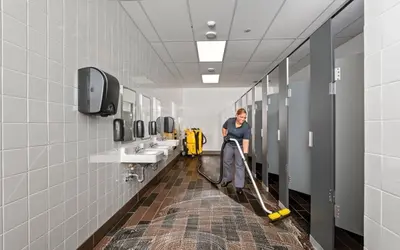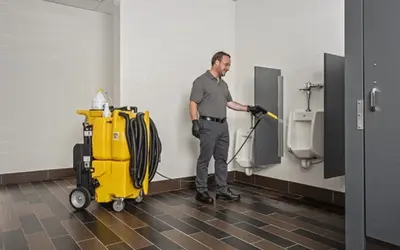Classroom Cleaning for Health

The new semester is about to start, and classroom cleaning for health is on everyone’s mind. Threats like flu, COVID, RSV, and common colds did not go away during breaks. But with everyone coming back together instances of these illnesses, and maybe some mysterious new ones, will ramp up. The result? More absences, lost productivity, worse learning outcomes, and increasingly frustrated teachers and parents.
Well maintained spaces can help curb the spread of illness, protecting everybody. Here are some of the risks of poor classroom cleaning and how to create cleaner, better learning environments.
Classroom Cleaning: More than Cosmetic
Poor classroom cleaning and irregular disinfection inevitably leads to bad outcomes. The most obvious is the spread of germs and viruses that make people sick. Elementary school children catch an average of eight to 12 colds or cases of the flu a year, while high schoolers catch about half that number.
Illness is miserable enough, but it also starts a ripple of more bad outcomes. For the individual child, missing even one day of school is associated with lower test scores, according to Michael Gottfried, a professor at the University of Pennsylvania Graduate School of Education. Their parents suffer too, missing an average of four workdays caring for their kids.
Absenteeism affects the school too. The Average Daily Attendance rate, a determinate in school funding takes a hit every time a student stays home, directly effecting the bottom line. Substitutes, required if illness spreads to the teacher, drain the budget further and disrupts classrooms.
Classroom Cleaning: It’s About More than Health
Poor classroom cleaning poses more than a health risk. It sends a message that the building, or in extreme cases, the entire district is poorly run. For proof, take a look at what happened at Chicago Public Schools over concerns around filthy classrooms.
“We want 100% satisfaction with our custodial services,” the Board of Education president Miguel del Valle said in an article in the Chicago Suntimes. “But all it takes is one problem, one school to get attention and all of a sudden, the generalizations occur, and schools are dirty.”
del Valle is correct. And while it may not be fair to the district as a whole, the damage is done. The district’s reputation is hurt. Parents, teachers, and the press are on alert. And administrators have to spend Board of Education meetings parsing answers.
Luckily the opposite is true. Studies show that clean spaces make students feel comfortable and more secure. Staff appreciate working in an orderly, well-maintained environment. Parents and visitors will also positively judge good classroom cleaning.
Classroom Cleaning: The Basics
Establishing, implementing, and maintaining a classroom cleaning and disinfection plan is vital to ensuring safe and just schools. The National Education Association lays out key measures, adopted from the CDC, to deliver safe in-person instruction. Their list includes:
- Selecting the right cleaning products and processes
- Determining the right approach for cleaning and disinfecting
- Knowing how—and how not—to use cleaning chemistry
- Using the right personal protective equipment
- Learning protocols for hard and soft surfaces, and eating and food prep areas
- Tailoring approaches for sensitive populations, for instance children and adults with asthma who may be sensitive to certain chemicals
A well thought out, well executed classroom cleaning plan does more than hamper the spread of illness. It provides talking points for beleaguered administrators. Share this plan with teachers and parents. Invite community input. Make school maintenance and classroom cleaning part of the messaging for better public buy-in.
Click here for more tips and tools for better classroom cleaning.
Related Posts

How to Clean a School Restroom
Clean school restrooms create a safe, welcoming environment. Students, staff, and parents expect sanitary conditions, especially in the restrooms. Anything less immediately effects morale and impacts learning.
Read more
Cherokee County School District Takes Cleaning into Their Own Hands With Kaivac
Each of the district’s six high schools maintained their restrooms with a No-Touch Cleaning system from Kaivac.
Read more